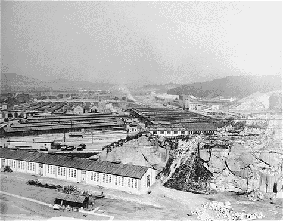Gusen (Austria)

General view of the camp after the liberation

General view of the camp after the liberation
Before the construction of the first Gusen Camp the prisoners of the Mauthausen Concentration Camp hat to march every day some 4km to reach the stone-quarries at Gusen. Because the death of more than 150 prisoners in winter 1938 to 1939 due to that everyday-march, decision was made in December 1939 to build a sub-camp of Mauthausen at Gusen. 400 German and Austrian prisoners from Mauthausen marched every day from Mauthausen to Gusen to construct some prisoners´ barracks, a few SS-barracks and an electric fence at Gusen until March 1940. At first, both camps (Mauthausen and Gusen) were under the command of the SS-Standartenfuehrer Franz Ziereis. In March 1940, SS-captain Karl Chmielewski came from KZ Sachsenhausen to be commander of the KZ Gusen Camp until 1943.
The first group of inmates was composed of German and Austrian political opponents and priests. These first prisoners had to work in the stone-quarries or had to build new installations in the camps. Due to the conditions of works and the incredible brutalities of the guards, this first group of inmates died after only some weeks. After the invasion of Poland by the Nazis, hundreds Polish Intellectuals and civilians were sent to Gusen and exterminated in the stone-quarry. The first group of Polish inmates arrived on March 9th, 1940. Within one year the population of Gusen grew from 800 to 4,000 inmates in spring 1941. More than 1,522 of them died in 1940 due to the heavy work in the stone-quarries of Gusen and the brick-production plant at Lungitz (became later Gusen III). End of 1941, the next group of inmates to be exterminated at Gusen by heaviest work had been Soviet Prisoners of War. This group of inmates was also the first to be gassed in 1942.
Several Spanish republican prisoners were sent also sent to Gusen and exterminated. More than 2,000 of them had to work in the stone-quarries and very few of them survived.
Several atrocities were committed by the SS and the kapos at Gusen. One of the "specialities" of this camp "Todebadeaktionen" (death bath action). This method of murder was the idea of SS sergeant Jentzsch. The SS captain Chmielewski was enthusiastic and decided to apply this new form of execution to the inmates. The inmates were selected to the "bath" during the appeal: inmates unable to work or ill. They were then sent to the "bath room" and had to stay naked under the showers. Then icy water under high pressure falled from the showers. The temperature of the bodies was falling down and caused a long and painful agony. Often, the inmates died only after an half-hour... During his trial, SS captain Chmielewski declared that the life of ill inmates and Jews had absolutely no value for him...
Two other camps were established later at Gusen: Gusen II (St Georgen) and Gusen III (Lungitz). The conditions of life in these two camps were incredible. The inmates had a surname for Gusen II : "The Hell of the hells"...
Austrian civilians forced to burry the victims of Gusen...The three camps at Gusen were liberated on May 5th, 1945 by the rec.squadron of sergeant Albert J.Kosiek. More than 37,000 inmates died at Gusen. This is more than 1/3 of all the victims of all the other camps located in Austria...
For more informations about the camps of Gusen, check the excellent site KZ Mauthausen Gusen: This site contains a huge documentation about this three camps.